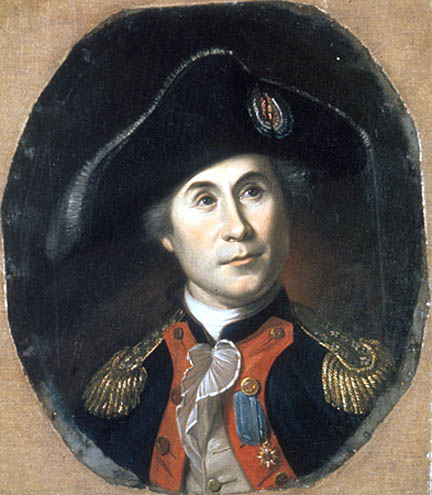The Revolutionary War created America’s first international naval hero, John Paul Jones. This lesson facilitates an appreciation for the character and legacy of John Paul Jones by analyzing his most memorable quotations and connecting them to the accomplishments of other historic figures and ordinary individuals who share Jones’ spirit.
Suggested Grade Level
Middle School
Recommended Time Frame
Two fifty-minute sessions.
Objectives and Essential Questions
Students will:
- collect evidence about the accomplishments of the father of the United States Navy, John Paul Jones,
- reflect on the famous words attributed to John Paul Jones, and
- research an individual—from the past or present—who embodies Jones’ spirit and character.
Materials and Resources
(in order of appearance)
- William Fowler, The Revolutionary War at Sea, April 5, 2013
- John Paul Jones biography
- Fokke, Simon, Paul Jones and two lists of “Avis au Commerce”
- Haid, Johann Elias, Johann Paul Jones. Befehlschaber einer Schwadron in Diensten der 13 Vereinigten Provinzen von Nord-Americka, 1779
- Peale, Charles Willson, John Paul Jones, c. 1781-1784 [see the gallery below]
Background Knowledge
Students should be familiar with the events of Revolutionary War, the international scale of the conflict, and the role of the Continental Navy.
Sequence and Procedure
As a class, review and discuss the six quotations attributed to Continental Navy hero John Paul Jones—what do they reveal about his character?
- “I have not yet begun to fight!”
- “An honorable Peace is and always was my first wish! I can take no delight in the effusion of human Blood; but, if this War should continue, I wish to have the most active part in it.”
- “I wish to have no connection with any ship that does not sail fast; for I intend to go in harm’s way.”
- “If fear is cultivated it will become stronger, if faith is cultivated it will achieve mastery.”
- “It seems to be a law of nature, inflexible and inexorable, that those who will not risk cannot win.”
- “Whoever can surprise well must conquer.”
Instruct students to take notes while watching William Fowler in the American Revolution Institute video The Revolutionary War at Sea, parts 1, 2, 3 and 4. Students should specifically record details about Jones’ accomplishments, and after watching the segments, they should discuss how his deeds relate to his famous words.
As a class read the short John Paul Jones biography attached to this lesson. Ask students to gather additional information about Jones that connect his life and character to his well-known quotations.
Have students consider three images of Jones—by Johann Elias Haid, Simon Fokke and Charles Willson Peale. Afterward, prompt students to describe the character and attitude projected by Jones’ likenesses. Based on this analysis, ask students to match Jones’ quotations to one of the three images.
Have students choose one of Jones’ quotations that they imagine could have been spoken by a different person from history or the present day. Direct students to research that individual and collect evidence about their character and accomplishments to analyze how that individual compares to the information they’ve gathered about John Paul Jones.
Assessment and Demonstration of Student Learning
Have students feature the John Paul Jones quotation they selected on an inspirational poster. The poster should also include an image of Jones that evokes the sentiment of the quotation, an image of their research subject, and a description of the character traits or accomplishments their research subject possesses that reflect the spirit of John Paul Jones.
Revolutionary Achievements Category
Independence
Exploring the Revolution Category
The Revolutionary War
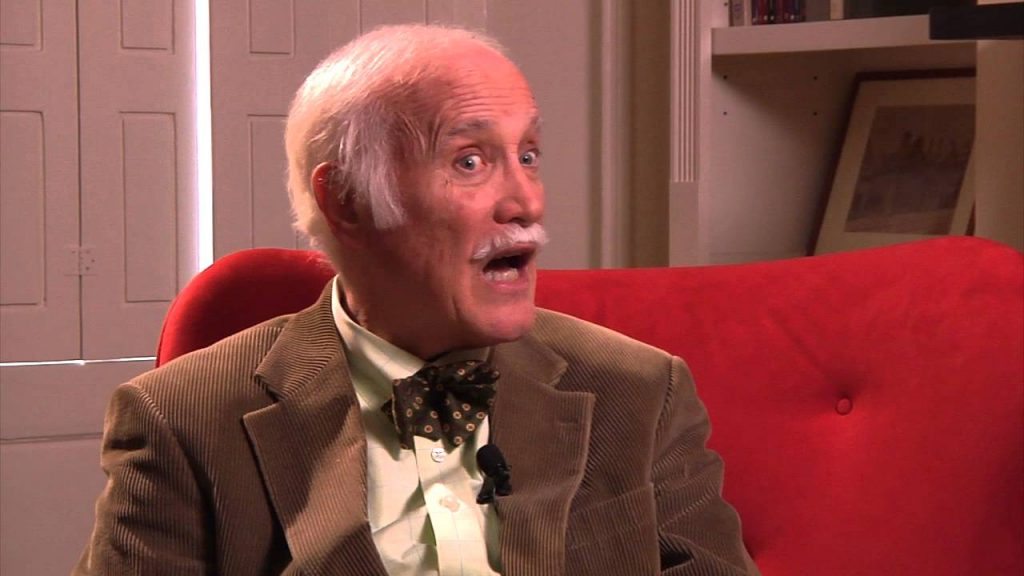
The Revolutionary War at Sea
William Fowler
April 5, 2013The American Revolution Institute of the Society of the Cincinnati
Battles at sea played a key role in securing American independence, even though the size and prowess of the Royal Navy dwarfed that of the nascent Continental Navy. John Paul Jones, who defeated the HMS Serapis, became the great hero of the American navy—both in his own time and to later generations of Americans. French intervention at the Battle of the Chesapeake made possible the decisive victory at Yorktown that ultimately led to the end of the war. Professor Fowler details these important events to tell the story of the Revolutionary War at sea.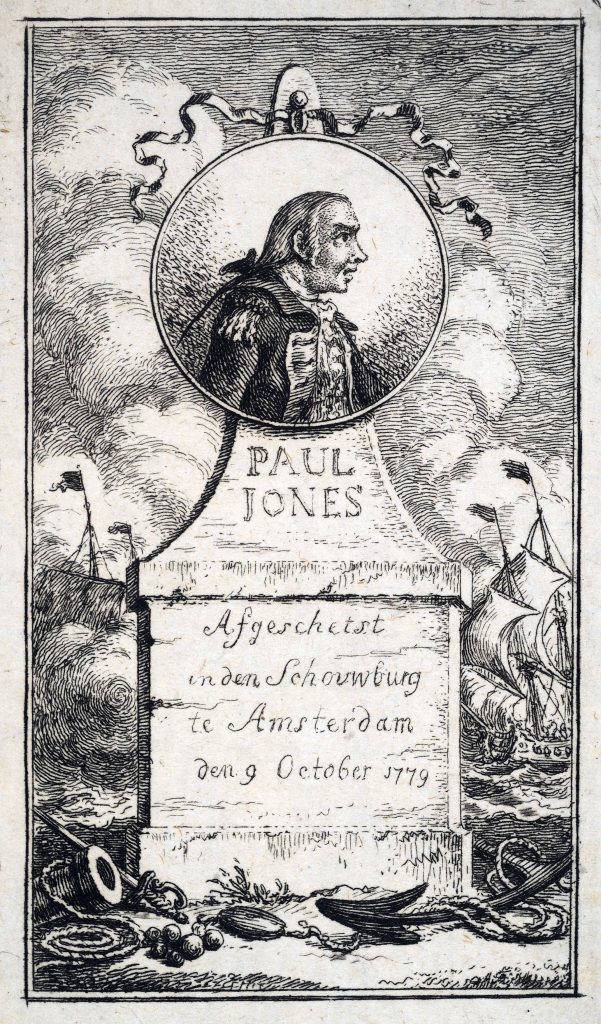
Paul Jones and two lists of “Avis au Commerce”
Simon Fokke
The American Revolution Institute of the Society of the Cincinnati
Portrait is shown hanging atop a pointed stone marker, with title on marker below portrait, ribbon at the top through the hook, and the following inscription on the base of the marker: "Afgeschetst in den Schouwbrug te Amsterdam den 9 October 1779." Below the marker are symbols of ships, i.e. anchor, ropes, cannon, a sword, etc. In the background, behind the marker, are two ships at sea. Provisions lists: both are lists of provisions for the Alliance, the Pallas, the Cerf, the Vengeance, and the Lagranville, on the orders of Mr. Jones, commander of the Bon-Homme Richard, dated 11 October 1779, and 13 October 1779. A reference in Morrison, John Paul Jones, a sailor's biography, states that this portrait is an etching by Simon Fokke of Amsterdam, and recognizes the ovation Jones received when he attended the theater on 9 October, 1779 in Amsterdam. Morrison claims this is one of the earliest authentic portraits of Jones. John Paul Jones was an original member of the Society of the Cincinnati from the state of Pennsylvania.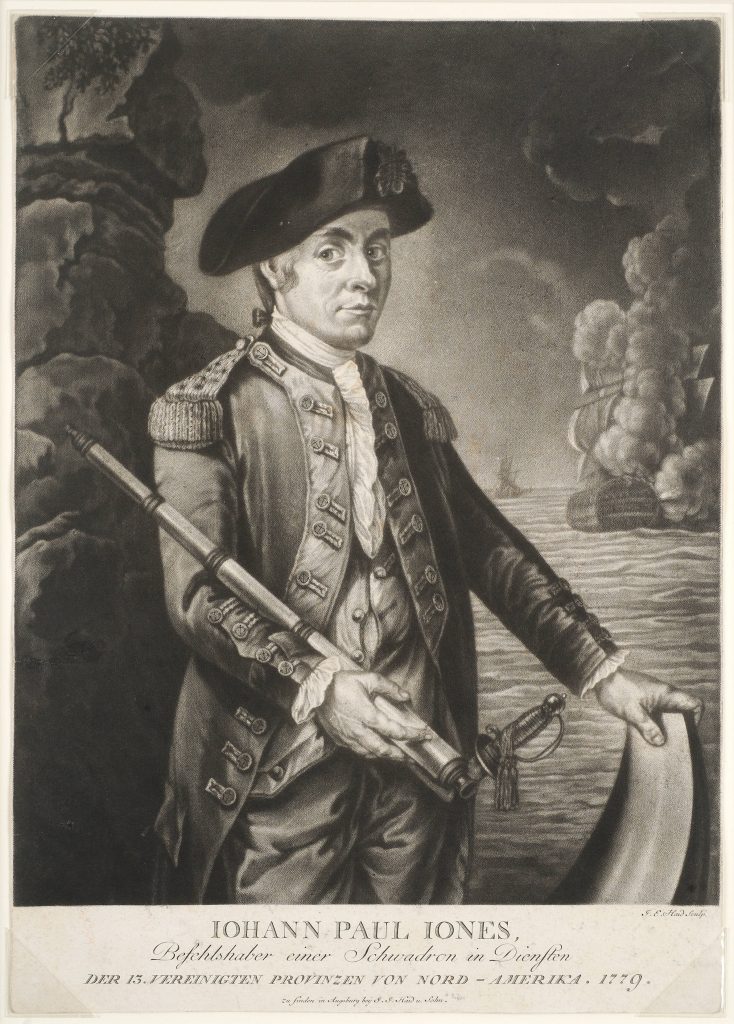
Johann Paul Jones, Befehlschaber einer Schwadron in Diensten der 13 Vereinigten Provinzen von Nord-Americka,Haid
Johann Elias
1779The American Revolution Institute of the Society of the Cincinnati
Three quarter length, standing, in uniform, wearing a hat, and holding a spyglass in his right hand. He is shown on the shoreline watching a naval battle in the right rear. The title translated reads: John Paul Jones, Commander of a Squadron in the Service of the thirteen United States of North America, 1779.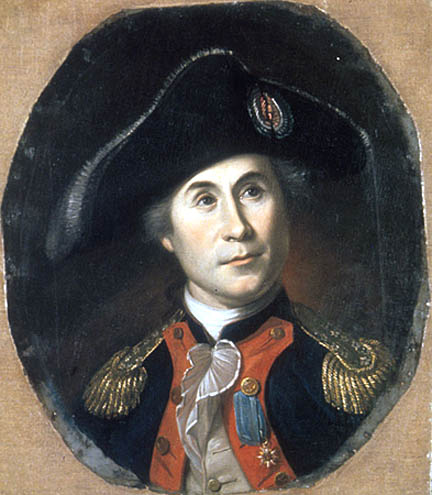
John Paul Jones
Charles Willson Peale
c. 1781-1784Independence National Historical Park
Charles Willson Peale may have painted his museum portrait of Jones as early as 1781. Jones wears the French Cross of the Institution of Military Merit [the gold medal hanging from blue ribbon through top left buttonhole]. Louis XVI presented this medal to him in 1780. Early in the following year, Jones returned to Philadelphia, where Congress confirmed his acceptance of the French decoration. Peale knew of the congressional honor and he may have taken Jones's portrait during the six-month period in 1781 when the captain was in America to receive it. On the other hand, Jones returned to Philadelphia in 1783; that may have been the occasion of this portrait. The portrait is listed in Peale's October 13, 1784 Freeman's Journal and Pennsylvania Daily Advertiser announcement of the museum. Jones and his exploits provided Peale with material for an additional museum endeavor. In 1786, the artist made the Gallant Action of Paul Jones in Taking the Serapis the topic of a painting for his moving picture exhibition.